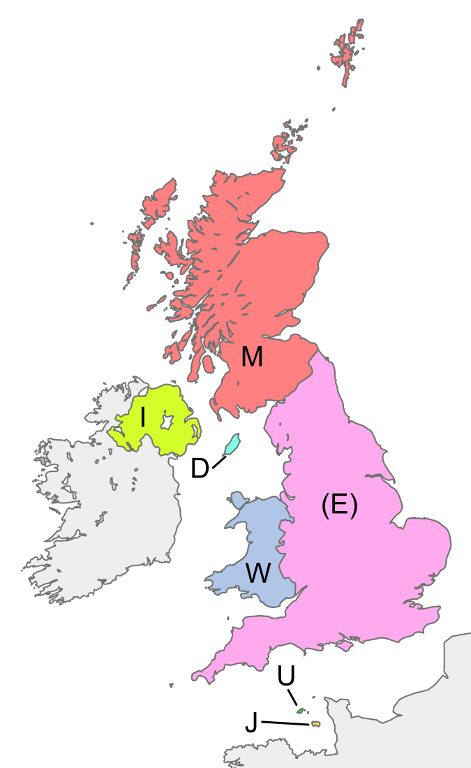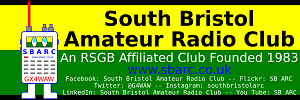Introduction
Amateur radio or ham radio call signs are unique identifiers for the 60,000 or so licensed operators in Great Britain. Call signs are regulated internationally by the 'International Telecommunication Union' (ITU) as well as nationally by Britain's 'The Office of Communication', known as Ofcom. It regulates amateur radio in the country as an independent regulator and competition authority for the UK communications industries, with responsibilities across television, radio, telecommunications and wireless communications services. It assigns call signs, issues amateur radio licences, allocates frequency spectrum, and monitors the radio waves.
The Radio Society of Great Britain (RSGB) is the United Kingdom's recognised national society for amateur radio operators. The society's patron is Prince Philip, Duke of Edinburgh and it represents the interests of the UK’s licensed radio amateurs.
Callsign Blocks for Telecommunication
The ITU has assigned Great Britain the following call sign blocks for all radio communication, broadcasting or transmission.
| Callsign Block | Principal Use |
|---|---|
| GAA – GZZ | Domestic |
| MAA – MZZ | Domestic |
| VPA – VQZ | Oceanic islands, Antarctica |
| VSA – VSZ | |
| ZBA – ZJZ | Gibraltar, Middle East, south Atlantic |
| ZNA – ZOZ | |
| ZQA – ZQZ | |
| 2AA – 2ZZ | Domestic |
While not directly related to call signs, the ITU further has divided all countries assigned amateur radio prefixes into three regions; Great Britain is located in ITU Region 1.
Callsign Assignments for Amateur Radio
Ofcom allots the individual call signs to the amateurs it licences. Call signs are the property of Ofcom even when assigned.
| Prefixes + letters in suffix | Licence class | Issue Dates and Details |
|---|---|---|
| M3 + 3 Letters | Foundation Licence | Jan 2002 – May 2008 |
| M6 + 3 Letters | Foundation Licence | May 2008 – date |
| 2EØ + 3 Letters | Intermediate Licence | 1991 – date. Originally issued as Class A Novice until 2001 when the Intermediate Licence was created. |
| 2E1 + 3 Letters | Intermediate Licence | 1991 – date. Originally issued as Class B Novice with restrictions to frequencies above 30MHz until 2001 when Intermediate Licence was created. In 2003 Morse was dropped as a requirement for HF access and Classes A and B were merged. |
| G1 + 3 letters | Full Licence | 1983 – 1988. Originally issued as a Class B (RAE only) licence with restriction to frequencies above 30MHz. Classes A (RAE + 12wpm CW/5wpm CW post 2001) and B (RAE only) were merged into the Full Licence following the removal of Morse requirements for access to HF frequencies in 2003. |
| G2 + 2 letters | Full Licence | 1920 – 1939. Automatically became Class A (RAE + 12wpm CW/5wpm CW post 2001) on the creation of Classes A (RAE + 12wpm CW/5wpm CW post 2001) and B (RAE only) in 1964. Classes A (RAE + 12wpm CW/5wpm CW post 2001) and B (RAE only) were merged into the Full Licence following the removal of Morse requirements for access to HF frequencies in 2003. |
| G2 + 3 letters | Full Licence | 1920 – 1939. Originally issued as "Artificial Aerial" licence. |
| G3 + 2 letters | Full Licence | 1937 – 1938. Automatically became Class A (RAE + 12wpm CW/5wpm CW post 2001) on the creation of Classes A (RAE + 12wpm CW/5wpm CW post 2001) and B (RAE only) in 1964. Classes A (RAE + 12wpm CW/5wpm CW post 2001) and B (RAE only) were merged into the Full Licence following the removal of Morse requirements for access to HF frequencies in 2003. |
| G3 + 3 letters | Full Licence | 1946 – 1971. Post 1964 these were Class A (RAE + 12wpm CW/5wpm CW post 2001) licences. The G3 + 3 letter callsigns issued prior to 1964 became Class A (RAE + 12wpm CW/5wpm CW post 2001) on the creation of Class A (RAE + 12wpm CW/5wpm CW post 2001) and B (RAE only) in 1964. Classes A (RAE + 12wpm CW/5wpm CW post 2001) and B (RAE only) were merged into the Full Licence following the removal of Morse requirements for access to HF frequencies in 2003. |
| G4 + 2 letters | Full Licence | 1938 – 1939. Automatically became Class A (RAE + 12wpm CW/5wpm CW post 2001) on the creation of Classes A (RAE + 12wpm CW/5wpm CW post 2001) and B (RAE only) in 1964. Classes A (RAE + 12wpm CW/5wpm CW post 2001) and B (RAE only) were merged into the Full Licence following the removal of Morse requirements for access to HF frequencies in 2003. |
| G4 + 3 letters | Full Licence | 1971 – 1985. Class A (RAE + 12wpm CW/5wpm CW post 2001). Classes A (RAE + 12wpm CW/5wpm CW post 2001) and B (RAE only) were merged into the Full Licence following the removal of Morse requirements for access to HF frequencies in 2003. |
| G5 + 2 letters | Full Licence | 1921 – 1939. Automatically became Class A (RAE + 12wpm CW/5wpm CW post 2001) on the creation of Classes A (RAE + 12wpm CW/5wpm CW post 2001) and B (RAE only) in 1964. Classes A (RAE + 12wpm CW/5wpm CW post 2001) and B (RAE only) were merged into the Full Licence following the removal of Morse requirements for access to HF frequencies in 2003. |
| G5 + 3 letters | Overseas | Originally issued to foreign nationals as a form of reciprocal ham radio licence. They were withdrawn and either they used existing home calls with additional UK prefix/ callsign, or if applicable they could apply for UK licence. |
| G6 + 2 letters | Full Licence | 1921 – 1939. Automatically became Class A (RAE + 12wpm CW/5wpm CW post 2001) on the creation of Classes A (RAE + 12wpm CW/5wpm CW post 2001) and B (RAE only) in 1964. Classes A (RAE + 12wpm CW/5wpm CW post 2001) and B (RAE only) were merged into the Full Licence following the removal of Morse requirements for access to HF frequencies in 2003. |
| G6 + 3 letters | Full Licence | 1981 – 1983. Originally issued to Class B (RAE only) with restrictions to frequencies above 30MHz. Classes A (RAE + 12wpm CW/5wpm CW post 2001) and B (RAE only) were merged into the Full Licence following the removal of Morse requirements for access to HF frequencies in 2003. |
| G7 + 3 letters | Full Licence | 1989 – 1996. Originally issued to Class B (RAE only) with restrictions to frequencies above 30MHz. Classes A (RAE + 12wpm CW/5wpm CW post 2001) and B (RAE only) were merged into the Full Licence following the removal of Morse requirements for access to HF frequencies in 2003. |
| G8 + 2 letters | Full Licence | 1936 – 1937. Automatically became Class A (RAE + 12wpm CW/5wpm CW post 2001) on the creation of Classes A (RAE + 12wpm CW/5wpm CW post 2001) and B (RAE only) in 1964. Classes A (RAE + 12wpm CW/5wpm CW post 2001) and B (RAE only) were merged into the Full Licence following the removal of Morse requirements for access to HF frequencies in 2003. |
| G8 + 3 letters | Full Licence | 1964 – 1981. Originally issued to Class B (RAE only) with restrictions to frequencies above 30MHz. Classes A (RAE + 12wpm CW/5wpm CW post 2001) and B (RAE only) were merged into the Full Licence following the removal of Morse requirements for access to HF frequencies in 2003. |
| GØ + 3 letters | Full Licence | 1986 – 1996. Originally issued to Class A (RAE + 12wpm CW/5wpm CW post 2001). Classes A (RAE + 12wpm CW/5wpm CW post 2001) and B (RAE only) were merged into the Full Licence following the removal of Morse requirements for access to HF frequencies in 2003. |
| MØ + 3 letters | Full Licence | 1996 – date. Originally issued to Class A (RAE + 12wpm CW/5wpm CW post 2001). Classes A (RAE + 12wpm CW/5wpm CW post 2001) and B (RAE only) were merged into the Full Licence following the removal of Morse requirements for access to HF frequencies in 2003. |
| M1 + 3 letters | Full Licence | 1996 – date. Originally issued to Class B (RAE only) with restrictions to frequencies above 30MHz. Classes A (RAE + 12wpm CW/5wpm CW post 2001) and B (RAE only) were merged into the Full Licence following the removal of Morse requirements for access to HF frequencies in 2003. |
| M5 + 3 letters | Full Licence | 1999 – date. Originally issued as a Class A/B (RAE + 5wpm CW) this licence group was upgraded to full Class A in 2001 when the CW requirements for access to the HF bands were reduced to 5wpm. Classes A (RAE + 12wpm CW/5wpm CW post 2001) and B (RAE only) were merged into the Full Licence following the removal of Morse requirements for access to HF frequencies in 2003. |
The above table draws on information published by Ofcom.

Regional two-letter prefixes are assigned according to the following table.

| Region | G-prefix | M-prefix | Intermediate | G-club prefix | M-club prefix | Special event |
|---|---|---|---|---|---|---|
| England | G | M | 2E | GX | MX | GB |
| Guernsey | GU | MU | 2U | GP | MP | GB |
| Isle of Man | GD | MD | 2D | GT | MT | GB |
| Jersey | GJ | MJ | 2J | GH | MH | GB |
| Northern Ireland | GI | MI | 2I | GN | MN | GB |
| Scotland | GM | MM | 2M | GS | MS | GB |
| Wales | GW | MW | 2W | GC | MC | GB |
Overseas Callsign Assignments
| Prefix | DXCC Entity |
|---|---|
| VP2E | Anguilla |
| VP2M | Montserrat |
| VP2V | British Virgin Isles |
| VP5 | Turks & Caicos |
| VP6 | Pitcairn Island |
| VR6 | Pitcairn Island (prior to 1 May 1998) |
| VP6D | Ducie Island (Pitcairn group) |
| VP8/F | Falkland Islands |
| VP8/G | South Georgia Island |
| VP8/O | South Orkney Island |
| VP8/SA | South Sandwich Island |
| VP8/SH | South Shetland Island |
| VP8 | Antarctica |
| VP9 | Bermuda |
| VQ9 | Chagos (Indian Ocean) |
| ZB, ZG | Gibraltar |
| ZC4 | UK Sovereign Base Areas on Cyprus |
| ZD7 | St Helena |
| ZD8 | Ascension Island |
| ZD9 | Tristan Da Cunha |
| ZF | Cayman Islands |
Special Event Callsigns
Ofcom reserves the right to issue temporary special event call signs to licensed amateurs holding a full licence.
Special event call signs are issued with a 'GB' prefix. An example of this is GB2BLE (Bristol Lundy Expedition) which the club uses for the annual DXpedition to Lundy Island. Ofcom also allows numerals in special event call sign suffixes; for instance GB75RD was a special event sign for the 75th anniversary of the Reading and District Amateur radio club.
Reciprocal Agreements
Holders of licences in countries signed up to CEPT TR 61-01[9] operate with their home call sign prefixed with an M/. Holders of licences in countries signed up to CEPT TR 61-02[10] can operate for 3 months before needing a Great Britain call sign as issued by Ofcom.
